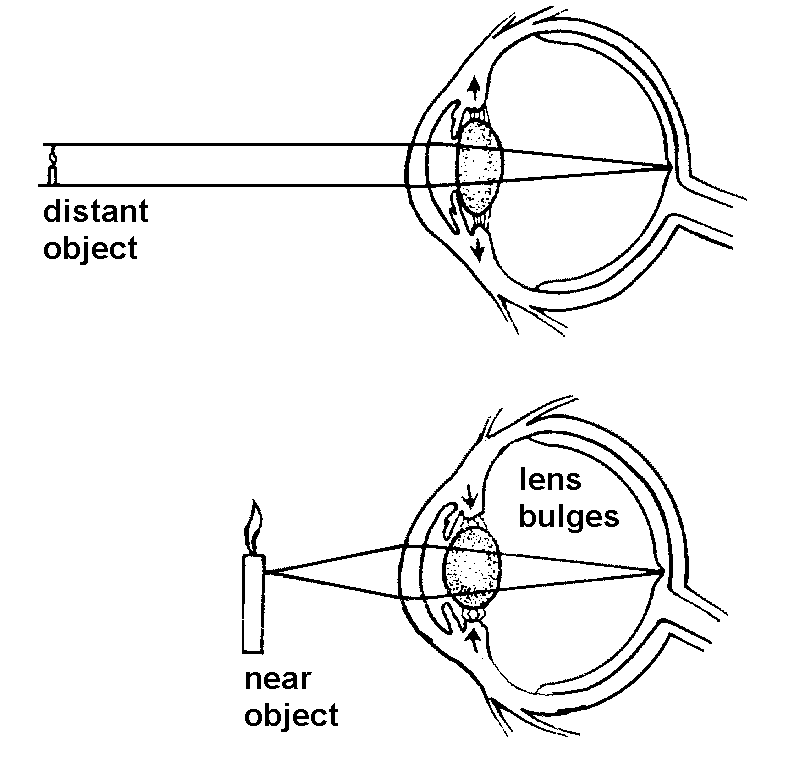BACKGROUND:
The eye is an organ
that reacts to light by sending signals to the brain. Use the enclosed
sheet as an overhead, or make copies for your students.
The eye captures light and images
through the lens, which then is picked up by the retina and transferred
to the brain through the nerves. If this system functions correctly,
a person will have normal eyesight. However, nature is not always
perfect all the time, so many humans have eyes that are not perfect.
Emphasize that the eye is an organ directly exposed to human mistreatment.
There are many susceptible areas around the eye, including the eyelids,
eyelashes, and the eye itself. Ask students how many times something
gets into their eyes per week. If organisms, especially bacteria,
get into the roots of the eyelashes, a local infection takes place known
as a stye. Organisms are also responsible for "pink eye," which is
highly contagious.
The lens of the eye is actually
like a glass or plastic lens, but the material is organic and is produced
by our body. The lens is not really "alive" because it doesn't require
blood or other nourishment after it is made. As a crystalline lens
grows, the younger layers are deposited around and on top of the older,
more condensed portions of the lens. The older the person gets, the
more a lens may change. A new born baby's lens is not formed completely,
so a baby doesn't really see as we see the first weeks of its life.
Cataracts are an overgrowth
of tissue over the lens of the eye. Many cataracts are caused by
the normal aging process.
Glaucoma means that there is
an increased pressure within the eye. If untreated it can cause blindness.
The gradual loss of nerve function causes loss of peripheral, or side,
vision painlessly and without notice.
Retinitis pigmentosa (RP) refers
to a group of diseases which tend to run in families and cause slow,
but progressive loss of vision. The retina is the tissue which lines the
inside of the eye and sends visual images to the brain.
Conjunctivitis, better known as “Pink Eye,” is the medical term that describes
an inflammation of the conjunctiva, the thin membrane that covers the white
of your eyes. This membrane produces mucus to coat and lubricate the surface
of the eye.
PROCEDURE:
- Discuss with
students what is an eye disease versus what is an variation of the condition
of the eye. Be careful
 on discussing myopia(far sightedness
- common in any given population) and hyperopia (near sightedness - common
in older people), which is common reason why children have glasses.
Some students may think that they have a real disease when they have glasses.
A disease is something that effects the eye, either by contracting a virus
or bacterial infection (i.e., pink eye) or which may be hereditary
(i.e., retinitis pigmentosa). If untreated a person could go blind
in some eye diseases. on discussing myopia(far sightedness
- common in any given population) and hyperopia (near sightedness - common
in older people), which is common reason why children have glasses.
Some students may think that they have a real disease when they have glasses.
A disease is something that effects the eye, either by contracting a virus
or bacterial infection (i.e., pink eye) or which may be hereditary
(i.e., retinitis pigmentosa). If untreated a person could go blind
in some eye diseases.
- Ask students if anyone
had problems with their eyes in the Lab. Discuss with them what might
be the problem. Remind students that our eyes are a guide to see
the world and we must take care of them. Students are sometimes unaware
that their eyesight is changing, or if they may see one color for another,
until an adult notices that the child may not be seeing what the normal
child sees.
- Students can research
more about eye diseases using the Internet or your school library.
Below are just two sites that may be helpful. Remember have students
use a search engine like http://www.yahoo.com
to help them find out more about
eye disorders. Use the worksheet to write down information.
http://www.eyenet.org/
This site is maintained by the American Academy of Ophthalmology.
|